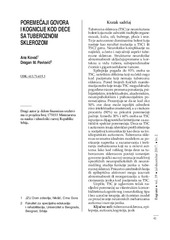Prikaz osnovnih podataka o dokumentu
Disorders of speech and cognition in children suffernig tuberous sclerosis
Poremećaji govora i kognicije kod dece sa tuberoznom sklerozom
| dc.creator | Kovač, Ana M. | |
| dc.creator | Pavlović, Dragan | |
| dc.date.accessioned | 2021-06-09T14:20:47Z | |
| dc.date.available | 2021-06-09T14:20:47Z | |
| dc.date.issued | 2017 | |
| dc.identifier.issn | 0351-2665 | |
| dc.identifier.uri | http://rfasper.fasper.bg.ac.rs/handle/123456789/1093 | |
| dc.description.abstract | Tuberous sclerosis (TSC) is a neurocutaneous disease whichcan affect multiple organs: the brain, skin, eyes, kidneys, lungs and heart. It is an autosomal dominant disorder whichoccurs as a result of mutations in the TSC1 or TSC2 genes. Neurological complications are the most common, and often the most important aspect of TSC. Structural neurological abnormalities include changes in the cerebral cortex in the form of tubers, subependymal nodules and giant cell tumors. Epilepsy affects up to 93% of people with TSC, with severe forms more common than in patients who do not have TSC. In addition to numerous physical manifestations, people with TSC may be affected by a range of behavioural disorders, psychiatric, intellectual, academic, neuropsychological and psychosocial disorders. It is estimated that about 50% of these children can exhibit a certain level of intellectual disability, and in a high percentage (90%) there are attention disorders. Between 30% and 60% of people with TSC meet diagnostic criteria for the autistic spectrum disorders (ASD). Children with TSC and autism demonstrate a profile of social communication impairment that has complete concordance with nonsyndromic ASD. TSC represents an ideal model for achieving progress in understanding and treating the mechanisms that underlie ASD. Although in a large number of children with TSC there is a change of speechlanguage development, there are very few specific neuropsychological or neuroimaging studies of the function of language in TSC. The presence of cerebral lesions or epileptic activity can cause abnormalities or reorganization in the functioning of the language in patients with TSC. In all, TSC is mostly a severe hereditary disorder with multiple comorbidities of cognitive and neurological type and no causal therapy, but also a useful model for studying neural mechanisms of autism and language developmen. | en |
| dc.description.abstract | Tuberozna skleroza (TSC) je neurokutana bolest koja može zahvatiti multiple organe: mozak, kožu, oči, bubrege, pluća i srce. To je autozomno dominantna bolest koja nastaje kao rezultat mutacija u TSC1 ili TSC2 genu. Neurološke komplikacije su najčešći, a često i najvažniji aspekt tuberozne skleroze. Strukturne neurološke abnormalnosti uključuju promene u korteksu u vidu tubera, subependimalne čvoriće i gigantocelularne tumore. Epilepsija pogađa do 93% osoba sa TSC, sa teškim oblicima koji su češći nego kod pacijenata koji nemaju tuberoznu sklerozu. Pored brojnih fizičkih manifestacija osobe koje imaju TSC mogudabudu pogođene nizom promena ponašanja, psihijatrijskim, intelektualnim, akademskim, neuropsihološkim i psihosocijalnim poremećajima. Procenjuje se da se kod oko 50% ove dece može ispoljiti određeni nivo intelektualne ometenosti, a u visokom procentu (90%) su prisutni poremećaji pažnje. Između 30% i 60% osoba sa TSC ispunjava dijagnostičke kriterijume za autistični spektar poremećaja. Deca sa TSC i autizmom imaju identičan profil oštećenja u socijalnoj komunikaciji kao deca sa tzv. idiopatskim autizmom. Tuberozna skleroza se smatra idealnim modelom za postizanje napretka u razumevanju i tretiranju mehanizama koji su u osnovi autizma. Iako kod velikog broja dece sa tuberoznom sklerozom postoji izmenjen govorno-jezički razvoj veoma je mali broj specifičnih neuropsiholoških ili neuroimidžing studija funkcije jezika u tuberoznoj sklerozi. Prisustvo cerebralnih lezija ili epileptična aktivnost mogu izazvati abnormalnosti ili reorganizaciju u funkcionasanju jezika kod pacijenata sa TSC. Uopšte, TSC je uglavnom težak nasljedni poremećaj sa višestrukim komorbiditetima kognitivnog i neurološkog tipa i bez uzročne terapije, ali i koristan model za proučavanje neuronskih mehanizama autizma i razvoja jezika. | sr |
| dc.publisher | Klinički centar Srbije - Klinika za psihijatriju, Beograd i Udruženje psihijatara Srbije, Beograd | |
| dc.relation | info:eu-repo/grantAgreement/MESTD/Basic Research (BR or ON)/175033/RS// | |
| dc.rights | openAccess | |
| dc.source | Engrami | |
| dc.subject | tuberous sclerosis | en |
| dc.subject | epilepsy | en |
| dc.subject | autism | en |
| dc.subject | cognition | en |
| dc.subject | language | en |
| dc.subject | tuberozna skleroza | sr |
| dc.subject | epilepsija | sr |
| dc.subject | autizam | sr |
| dc.subject | kognicija | sr |
| dc.subject | jezik | sr |
| dc.title | Disorders of speech and cognition in children suffernig tuberous sclerosis | en |
| dc.title | Poremećaji govora i kognicije kod dece sa tuberoznom sklerozom | sr |
| dc.type | article | |
| dc.rights.license | ARR | |
| dc.citation.epage | 51 | |
| dc.citation.issue | 2 | |
| dc.citation.other | 39(2): 41-51 | |
| dc.citation.rank | M51 | |
| dc.citation.spage | 41 | |
| dc.citation.volume | 39 | |
| dc.identifier.fulltext | http://rfasper.fasper.bg.ac.rs/bitstream/id/78/1090.pdf | |
| dc.identifier.rcub | https://hdl.handle.net/21.15107/rcub_rfasper_1093 | |
| dc.type.version | publishedVersion |


